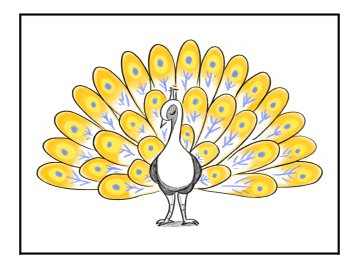
The Golden Peacock — A Cultural Symbol
Since antiquity, the peacock has often been used as a motif in ornamental design, a specimen of beauty and grace.
The idea of the “golden peacock”, however, is specific to Yiddish folktales and folksongs. This golden peacock often plays the role of a messenger between loved ones who find themselves separated from one another, like a bride and groom, or parents and a child.
The rise of modern Yiddish literature saw the use of this motif in literary works. Writers broadened the symbolic range of the golden peacock so that the creature came to stand for the creative forces of the Jewish people, and to represent longing for a lost sense of rootedness at a time and in a place long gone.
The symbol caught on in the Yiddish cultural sphere to such an extent that the phrase "the golden peacock" became the title of a volume of poetry, a novel, a collection of songs for a Yiddish school, an anthology of Yiddish poetry in English translation, as well as the name of a Yiddish theater ensemble and a Yiddish publishing house.
Nowadays, the culturally loaded image of the golden peacock serves as the logo of such institutions as Yiddishpiel, a Yiddish language theater company in Israel, and In Geveb, an online journal of Yiddish studies.
At the end of the movie, you can hear an extract of a Yiddish song by Beyle Schaechter-Gottesman. Below, hear and read the whole song, and learn more about this remarkable writer, musician, and artist.
וואָס קוקט עס דאָרט אַרויס פֿון דר׳ערד?
וואָס קוקט עס דאָרט אַרויס פֿון דר׳ערד?
אַ בלימעלע, אַ בלימעלע!
וואָס זינגט עס אויפֿן בוים דאָרט, הערט?
אַ פֿייגעלע, אַ פֿייגעלע!
אַ בלימעלע בליט, אַ פֿייגעלע זינגט,
אַ פֿלאַטערל פֿליט, אַ זשאַבקעלע שפּרינגט,
דער פֿרילינג איז שוין דאָ.
דער פֿרילינג איז שוין דאָ.
דער פֿרילינג איז געקומען, יאָ!
דער פֿרילינג, דער פֿרילינג!
דער ליבער פֿרילינג איז שוין דאָ!
דער פֿרילינג, דער פֿרילינג!
אַ בלימעלע דאָ, אַ פֿלאַטערל דאָרט,
סע זינגט און שפּרינגט אויף יעדן אָרט,
דער פֿרילינג איז שוין דאָ.
דער פֿרילינג איז שוין דאָ.
Text and music can be found in:
Beyle Schaechter-Gottesman, Fli, mayn flishlang (New York: League for Yiddish, 1999).
The recording is on the CD:
Beyle Schaechter-Gottesman, Fli, mayn flishlang (2006).
Beyle Schaechter-Gottesman (1920 — 2013) grew up in Czernowitz (then in Romania, today in Ukraine). Her father worked to promote use of the Yiddish language and her mother was an accomplished folksinger with a large repertoire of Yiddish folksongs. Arriving in New York in 1951, Schaechter-Gottesman and her family settled near other Yiddish-speaking families. She began to write for her children and for their Yiddish school, and she also wrote poetry and songs that portrayed aspects of her life both in Europe and in the US. In addition to her writing, she was a prolific painter and sketch artist. Between her own repertoire of Yiddish folksongs and her original songs, she inspired a new generation of Yiddish singers.

